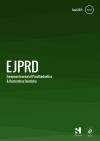European Journal of Prosthodontics and Restorative Dentistry

- Cover Date:
- Sept 2015
- Print ISSN:
- 0965-7452
- Electronic ISSN:
- 2396-8893
- Vol:
- 23
- Issue:
- 3
The Effect of Water or Wax-based Binders on the Chemical and Morphological Characteristics of the Margin Ceramic Framework Interface
doi: 10.1922/EJPRD_1333Güler07
The Effect of Water or Wax-based Binders on the Chemical and Morphological Characteristics of the Margin Ceramic Framework Interface
Umut Güler, José Renato Cavalcanti de Queiroz, Luiz Fernando Cappa de Oliveira, Senay Canay, Mutlu Özcan
This manuscript is dedicated to the life of Dr Umult Güler, 1st author, who passed away suddenly before the article was published
ABSTRACT
This study evaluated the effect of binder choice in mixing ceramic powder on the chemical and morphological features between the margin ceramic-framework interfaces. Titanium and zirconia frameworks (15x5x0.5 mm3) were veneered with margin ceramics prepared with two different binders, namely a) water/conventional or b) waxbased. For each zirconia framework material, four different margin ceramics were used:
a- Creation Zi (Creation Willi Geller International); b- GC Initial Zr (GC America); Triceram
(Dentaurum); and d- IPS emax (Ivoclar Vivadent).
For the titanium framework, three different margin ceramics were used: a- Creation Ti (Creation Willi Geller International); b- Triceram (Dentaurum); and c- VITA Titaniumkeramik (Vita Zahnfabrik).
The chemical composition of the framework-margin ceramic interface was analyzed using Energy Dispersive X-ray Spectroscopy (EDS) and porosity level was quantified within the margin ceramic using an image program (ImageJ) from four random areas (100 x 100 pixels) on each SEM image. EDS analysis showed the presence of Carbon at the margin ceramic framework interface in the groups where wax-based binder technique was used with the concentration being the highest for the IPS emax ZirCAD group. While IPS system (IPS ZirCAD and IPS Emax) presented higher porosity concentration using wax binder, in the other groups wax-based binder reduced the porosity of margin ceramic, except for Titanium - Triceram combination.
Keywords
All ceramics
Ceramics
Margin ceramics
Porosity
Scanning Electron Microscopy
- Article Price
- £15.00
- Institution Article Price
- £
- Page Start
- 128
- Page End
- 134
- Authors
- Umut Güler, José Renato Cavalcanti de Queiroz, Luiz Fernando Cappa de Oliveira, Senay Canay, Mutlu Özcan
Articles from this issue
- Title
- Pg. Start
- Pg. End
- The Effect of Water or Wax-based Binders on the Chemical and Morphological Characteristics of the Margin Ceramic Framework Interface
- 128
- 134
- Evaluation of Chlorine Dioxide Irrigation Solution on the Microhardness and Surface Roughness of Root Canal Dentin
- 135
- 140
- Choosing the Right Dental Material and Making Sense of the Options: Evidence and Clinical Recommendations
- 150
- 162
